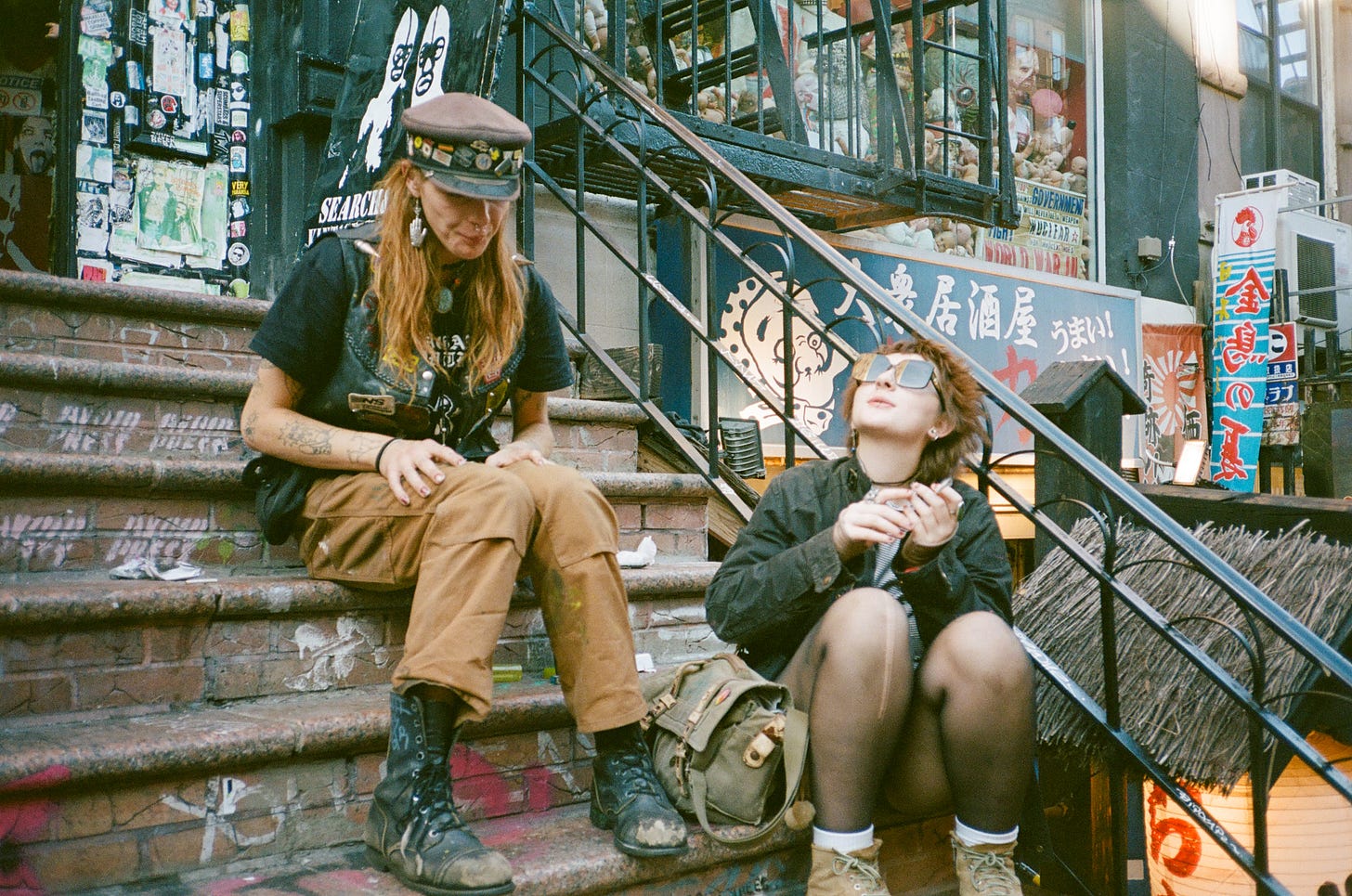St. Marks Place may be dead, but one stoop lives on
Catching up with the young punks who still gather on the steps of Search & Destroy.
Welcome to: The Last Stoop, a series on St. Marks Place, its storied steps, and the kids who still claim them.
In high school, St. Marks Place offered irresistible prospects. Piercings without ID checks. Alcohol in exchange for a quick flash of the shittiest fake. Danger and adventure packed into three grimy blocks between Astor Place and Tompkins Square Park— streets we feared and romanticized after watching Larry Clark’s Kids.
For a couple of slightly buzzed virgins, hoping their new industrial piercings and throbbing cartilages signaled they belonged here, St. Marks was a mecca of recklessness. The Search & Destroy stoop in particular was home base for punks, crusties, freaks, and runaways. Walking past those stairs, sipping our paper-bag beers, we were close enough to the loudness, to the drinking and drugging, to inhale their chaos. They were freaks. And so was I, though I hadn’t grown into it yet.
By then, in 2011, St. Marks was long considered “dead.” It had gone through numerous incarnations—as an immigrants’ refuge, a mafia war zone, an outcast paradise, and backdrop to some of the most beloved art, activism, and music of the 20th century. In the 1960s, Warhol staged the Velvet Underground’s Exploding Plastic Inevitable at the Dom. Soon after, the upstairs ballroom became the Electric Circus, where Bowie and The Stooges made their mark on stage. Club 57 birthed Haring and Madonna. Trash & Vaudeville dressed the punks. The Stones shot Waiting on a Friend at the same tenement façade Zeppelin used for Physical Graffiti. Decades ago, you could get mugged or pick up the clap hanging here; now it was more like the Epcot of grime. Still, it was magical.
Declaring a neighborhood “dead” is a beloved New York pastime. Ada Calhoun, journalist and East Village local who wrote St. Marks Is Dead, put it best: “Disillusioned St. Marks Place bohemians—those who were Beats in the fifties, hippies in the sixties, punks in the seventies, or anarchists in the eighties—often say the street is dead now, with only the time of death a matter of debate. But… at every cohort’s arrival, the flowering of its utopia, killed someone else’s.”
Yet, discord has remained an integral part of the street’s character. And even as the block was gentrified, whitewashed, and sanitized, plenty of punkish types are still pulled to these three blocks to find community—and to claim a little piece of history.
Search & Destroy, named after the Stooges song, is one of the remaining relics of a tougher past. It’s touted as the last authentic punk shop left on a block that was once a hub for secondhand clothing. Designed to draw the right clientele and scare off the rest, Search & Destroy cultivates an abrasive, confrontational vibe. In the front window display, naked baby dolls and skeletons are piled like a mass grave. A step inside reveals plastic animal carcasses, mannequins in bondage, and elaborate gas masks. If you can stomach the jarring décor, the store has an arsenal of band tees, boots, studded leather, iron-on decals, belts, sex toys, and costume gear in its cramped quarters.
Since moving back to the East Village, walking past the steps of Search & Destroy to rubberneck has become a daily routine. A 20-year-old in fingerless gloves sips a 40 oz of malt liquor at four in the afternoon. A scruffy biker with half his teeth has pedaled in from the Bronx to show off his new rig. The stairs are the stage for a revolving cast of characters who call this street home.
Sure, St. Marks is dead. But youth is eternal, and right now it’s congregated on the steps of Search & Destroy. They’re kind, suspicious, a little lost. They’ve got the best fashion in the city. They want to drink beer and laugh with friends. So on a warm September Sunday, I asked if I could sit with them. Stickers, Erick, and Allison told me why they still come here—and what the Search & Destroy stoop means to them.
How old are you?
ALLISON: 22.
STICKERS: 23.
ERICK: 25.
Where are you from?
ERICK: Here.
STICKERS: New York.
ALLISON: Albany.
How often do you come here?
ALLISON: Every day.
STICKERS: Every day.
ERICK: Yeah, almost every day.
Why do you come?
STICKERS: I have no idea how I ended up here, but I've been hanging out on these steps for like 10 years. You see photo of these stairs from the 80s and 90s and you’re gonna find what was in those photos still to this day. Decades and decades of youth have been lost and somehow magically gravitate right here. This place used to be a rehab center and Search & Destroy was on the ground level. And before it was a rehab, it was some crazy sex carvel place. Given the history of this neighborhood, it’s nice to be sitting up here and keeping something alive.
Do you make friends from hanging out here on the stoop?
STICKERS: I’ve made friends. I’ve made enemies. But honestly, just the fact that I can come here and I’m not alone in the type of character I am. You’re always gonna find runaways. This is the only place in the city you will find people who ride trains. The thing that really keeps me coming here, all bullshit aside, is the fact that I can just be myself.
What does it mean to have a place where you can always roll up and know that there will be people here waiting for you?
ALLISON: I think it’s something that very few people have.
STICKERS: A lot of us don’t have family or a home. It’s a pretty fucked up family on these steps, but when shit hits the fan, someone will have your back. It’s home away from home. Even if I lost my apartment in the Bronx, got evicted, I always know I’ll be welcome here and known and someone asking, Oh, how was your day? Are you okay?
ALLISON: People will help you out too. We share everything.
Is there anywhere else in the city that’s like this?
ERICK: No.
STICKERS: The closest is Washington Square Park. But it’s changed. After COVID, it’s been whitewashed. They started criminalizing the artists.
What’s inspiring you right now?
ALLISON: I just found a big ass canvas on the street. I stood by it for like five minutes in case somebody came back for it. I’m like, no way someone left this out here.
STICKERS: I’m gonna go out freight hopping in a few day. I have to leave every once in a while. You get caught up in the city and it eats you alive. You forget that there’s a world outside New York. Sometimes you have to remind yourself how shitty the rest of the world is. You gotta see some open plains. You gotta see some trees. Remind yourself that there’s other things in the world other than New York. People get stuck here. You’ll find someone walking down this block who has never left.
ERICK: A bunch of shit. History. It’s important to keep history alive.
And how do you do that?
ERICK: This. Word of mouth. You gotta know what you’re talking about.









i have been meaning to go to this shop for YEARS, over the time i’m visited and also now that i (somewhat recently) moved here. such a great story! :’) glad it’s still a refuge for people
Sooo good. These three souls in the midst of it all--the art, history, grime--seem at once completely lost and also found. A delicious piece of journalism!